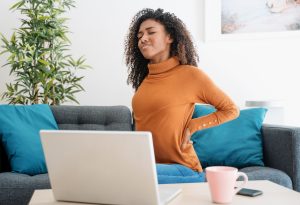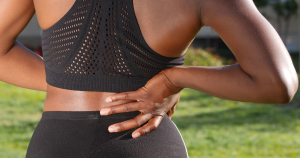Low Back Pain: Common Causes, Prevention, and Treatment
 Have you been battling with an achy low back? If you work a sedentary job, you likely have felt a painful low back after a full day of work. While maintaining a poor posture is a common cause of this pain, low back pain can present itself in many different ways, including improper lifting, occupational tasks, sustained postures, overuse and sports injuries, lifestyle, weight, disease, and degenerative (age-related) arthritis.
Have you been battling with an achy low back? If you work a sedentary job, you likely have felt a painful low back after a full day of work. While maintaining a poor posture is a common cause of this pain, low back pain can present itself in many different ways, including improper lifting, occupational tasks, sustained postures, overuse and sports injuries, lifestyle, weight, disease, and degenerative (age-related) arthritis.
Low back pain is one of the most prevalent injuries and causes of physical therapy treatment. Most people will have some form of low back pain in their lifetime. And depending on the nature of low back pain, it can either be acute or chronic. Orthopaedic Hospital of Wisconsin physical therapist Alexis Lindstrom, PT, DPT, of Shorewood Physical Therapy, describes the common causes, prevention, and treatment options for low back pain in the blog post below.
Common Causes of Low Back Pain
Postures

Prolonged postures can increase pain and discomfort within the spine. Most people often experience prolonged postures while working sedentary jobs that require desk work or little movement. Improve your posture while sitting for a long time by having a proper ergonomic desk, screen, and chair setup. Or even try a standing desk.
If these prolonged sitting postures occur while working from home, ergonomics will be more important than ever. While in a home environment, it’s tempting to work on the couch or slouch over the kitchen table. But it’s vital to ensure you exercise proper desk ergonomics to avoid low back pain. One tip to improve seated positions is keeping your hips higher than your knees to prevent increased slouching. Limit crossing your legs and keep your feet flat on the floor.
Another common cause of aches and pains is sleeping posture. Avoid sleeping on your stomach and crossing one leg over the other while on your side. Using a pillow to improve neutral alignments will help avoid undue stress caused by increased rotation and compression. Keeping your neck in a straight line will also limit the mornings you wake up to those nagging “kinks” in your neck that affect you for the rest of the day.
Lifting
Lifting is another frequent injury when it comes to low back pain. Making sure to keep heavy items close to the body is extremely important. When picking up items, never fold at the waist. Instead, bend your knees and keep the object you lift close to your body while limiting twisting.
Age
Aging is inevitable. As time passes, we may experience bodily changes that lead to low back pain. Over time, the discs in our spine lose their height and offer less protection to our vertebral bodies. Some aging spine disorders include degenerative disc disease (DDD), spinal stenosis, osteoarthritis, arthritis, disc bulges, or disc herniations. However, this does not mean we should stop exercising and staying active. As we age, it is common to have an increasingly sedentary lifestyle. Exercise is even more essential to sustain muscular strength and functional mobility.
Prevent Low Back Pain
 While preventing a low back injury is not always possible, you can reduce your risk for injury through a healthy lifestyle. Exercising and maintaining a healthy body weight will decrease the extra load on the spine. Exercise is also necessary to strengthen and activate your core, which also helps to stabilize your spine. Light stretches before and after any activity will also improve spine mobility.
While preventing a low back injury is not always possible, you can reduce your risk for injury through a healthy lifestyle. Exercising and maintaining a healthy body weight will decrease the extra load on the spine. Exercise is also necessary to strengthen and activate your core, which also helps to stabilize your spine. Light stretches before and after any activity will also improve spine mobility.
It’s also important to remember to lift with proper technique. Employing the correct lifting techniques will lower your risk of experiencing a painful muscle strain that can lead to a low back injury. And while you cannot always avoid back pain caused by a disease or a structural abnormality, it often can be managed with proper treatment.
Physical Therapy Treatment
Physical therapy is a primary conservative treatment for acute and chronic low back pain. Whether you get a referral from a physician or feel you want improvements in pain and function, physical therapy is an excellent option for you. Your personalized treatment plan will be tailored to your pathology and adjusted to your needs for improvements in your overall health. Your therapist will go through exercises and hands-on tasks to educate you on better movement patterns and point out deficits. If a physical therapist feels more in-depth findings are necessary, they may refer you to an OHOW back/spine specialist.
Physical Therapy Options for Low Back Pain Include:
- Assessment of movement patterns
- Lifting mechanics
- Manual Therapy
- Core activation and postures
- Strengthening and flexibility exercises
- Improved functional movements
- TENS unit for pain relief
- Dry Needling
If you are experiencing low back pain that requires treatment, our skilled medical providers and therapists will help get you back in working order. Don’t hesitate to make an appointment online or call (414) 961-6800.

